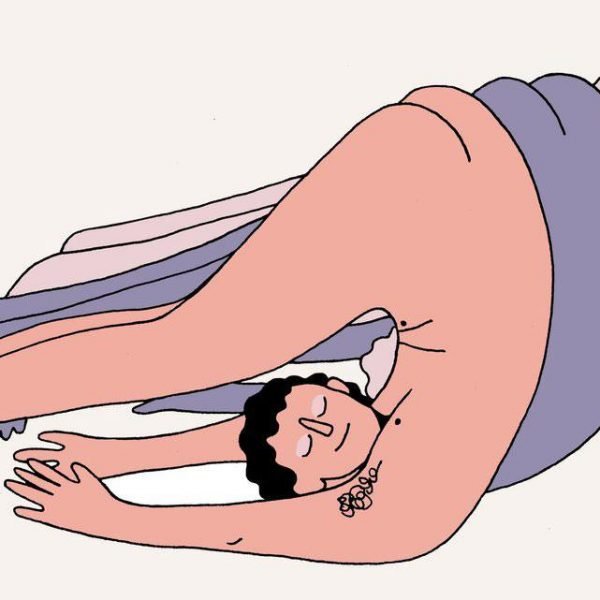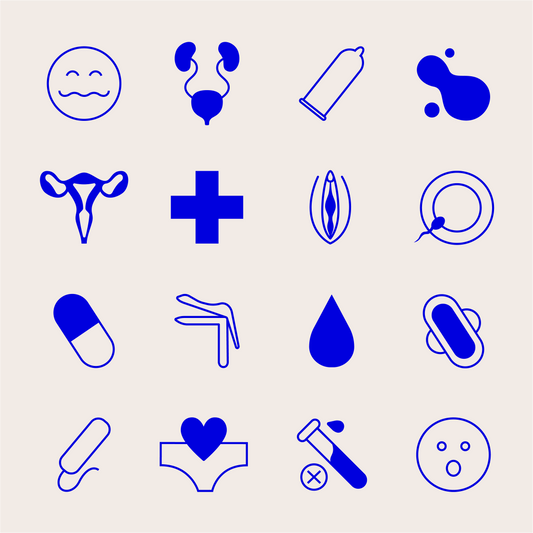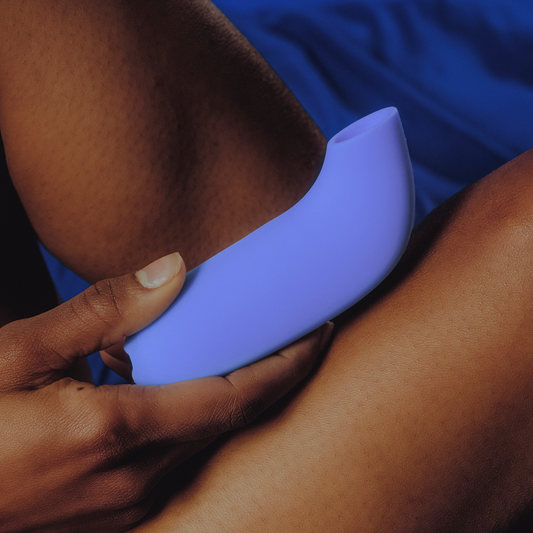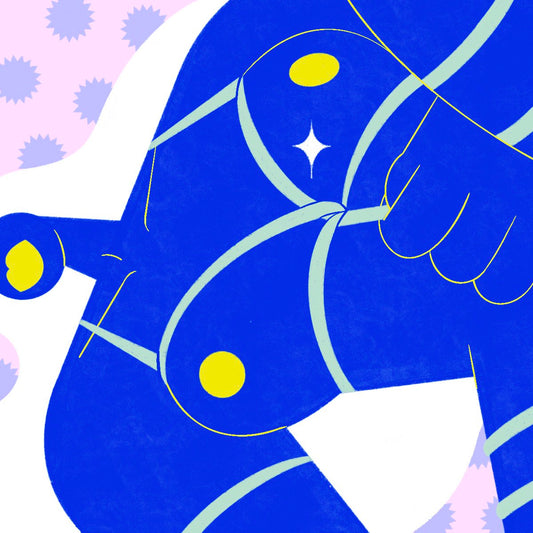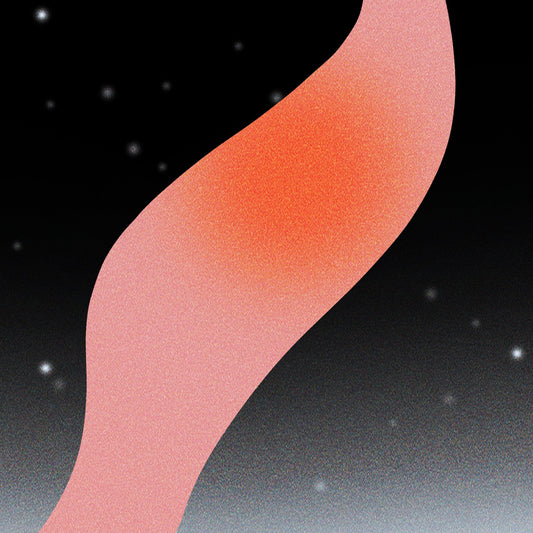Alexandra Fine, Credentialed Sexologist, M. Psych | Written by Dame
Ever Heard of the P-Spot? | The Prostate Gland and Sexual Function | The P-Spot Is an Erogenous Zone | Finding the P-Spot | The P-Spot and Sexual Satisfaction | The P-Spot and Prostate Wellness
Cisgender men have pretty much dominated the world since – well – forever.
So it only seems fair that in recent years, most sociological and popular attention has been focused on the sexual needs of vulva-havers instead of penis owners.
There are numerous examples. They range from the widespread availability of the birth control pill and the development of sex-positive feminism, to the depictions of “female sexuality” in Sex and the City and the latest incarnation of Wonder Woman.
This quantum societal shift still has a long way to go, particularly when it comes to the transgendered, non-binary and gender fluid communities. Even so, it has made many who were assigned male at birth feel slighted.
“Why is so much attention paid to the G-spot?” you can hear them ask. “Why is it always about the p---y these days? Why isn’t there a male G-spot? Why have guys been left behind?”
No worries, little buddy. You’ve got a spot that’s all your own: the P-spot. And “left behind” is an apt way to put it – since we’ll be paying a lot of attention to your behind.
Have You Ever Heard of the P-Spot?
Even if the term is new to you, you’re probably familiar with the proper anatomical name for the P-spot: the prostate gland. The prostate is a key part of the reproductive system, and it plays a major role in “male sexual health.” But most penis-havers only think about their prostate when it’s begun to cause problems.
That’s because the gland is likely to grow in size as they age. The medical term for an enlarged prostate is benign prostatic hyperplasia (BPH), and it’s the reason why so many cisgender men (and those assigned male at birth) experience urinary issues in their 50s, 60s and beyond. The most common signs of BPH are frequent urination, incomplete emptying of the bladder, and regular urinary tract infections.
BPH is the least-problematic prostate issue that penis owners can experience. Prostatitis is an inflammation of the prostate gland, which can occur at any age. Some cases are chronic while others are caused by infection; they’re often difficult to treat and can cause extreme pain in addition to urinary issues.
The most serious prostate issue, as you’d probably guess, is cancer. Prostate cancer is the most common malignancy experienced by penis-havers – although there are effective treatments if the disease is diagnosed early. Around 13% of Americans with prostates will eventually develop prostate cancer, with the risk increasing as they grow older. Genetics also play a role, as does race, with African-Americans twice as likely to develop the disease.
That’s certainly a downer. At first blush, the prostate doesn’t sound like it’s any match for a vulva-haver’s G-spot when it comes to sexual pleasure. It doesn’t even sound like it deserves a cool name like “P-spot.”
Stay with us. All we’ve established so far is that the prostate gland has a public relations issue: most people only know about the “bad stuff” that can happen. It’s time to learn about the “good.”
The Prostate Gland and Sexual Function
The prostate gland plays an important role in the reproductive system, even though it’s only about the size of a walnut.
The gland is located between the penis and the rectum. It sits just underneath the bladder, and surrounds the upper portion of the urethra (the tube between the penis and the bladder). The prostate’s proximity to the bladder and urethra is the reason it causes urinary problems when it grows in size.
That’s exactly where the prostate gland needs to be, though. One of its primary functions is to supply fluid that, when mixed with other seminal fluid (produced in the seminal vesicle) and sperm (produced by the testicles), creates semen. And the prostate’s role doesn’t stop there; its muscles are responsible for pumping ejaculate into the urethra – and out through the penis – during orgasm.
It’s true that ejaculation feels really good. But that’s not what we’re referring to, when we say that the P-spot can rival the G-spot for creating and delivering sexual pleasure.
We’re talking about prostate massage and prostate orgasms.
The P-Spot Is an Erogenous Zone
Researchers and sex educators believe that stimulating the P-spot feels good for two reasons. First, the prostate is very sensitive because it’s loaded with nerve endings. Second, the gland swells quite a bit during arousal, making the area easier to locate and even more sensitive.
But feeling good isn’t the only reason to focus on the P-spot. Effective prostate stimulation can actually lead to orgasm.
Prostate orgasms feel much like standard penile orgasms, but they’re usually more intense. In fact, they’re felt so deeply that they’re often described as full-body orgasms. Some prostate owners report that, with practice, they can experience multiple P-spot climaxes (or “super orgasms”) which rapidly come one after another. Prostate orgasms don’t usually result in full-scale ejaculation; they’re more likely to be accompanied by a small amount of semen seeping out from the penis.
If you’re not familiar with prostate orgasms, it may be because you haven’t wanted to know about them – since the prostate is best accessed from the rear.
That’s right. It’s time to discuss butt stuff.
Finding the P-Spot
The prostate is located in front of the rectum, but you can’t get to it easily. The penis and scrotum are in the way.
That’s why the best way to find and massage the prostate is by anal exploration. (Prostate massage is a term commonly used to mean prostate stimulation, although prostate massage therapy is also used to treat medical conditions including chronic prostatitis and erectile dysfunction.)
Is going in the back door really necessary?
Well, you can find the P-spot indirectly by pressing on the soft, spongy area toward the back of the perineum, which is the area between the anus and the testicles that’s sometimes referred to as the “taint.”
Once you’ve located the prostate, a variety of firm but gentle strokes is best for stimulation. Not everyone can find it that way, not everyone who does will derive much pleasure from stimulating it, and it’s extremely rare to actually climax from external prostate stimulation. For some, though, it can definitely feel good and it’s a fun variation in partner sex play.
Some penis-havers also enjoy indirect pressure applied to the prostate by pushing on the anus from the outside. Again, it can feel good, but it’s unlikely to induce an orgasm.
So the most reliable – and satisfying – approach is through the anus.
Before starting your search for the P-spot, you should know some very important things about anal play.
- The anus and rectum do not produce lubrication, and their thin tissues are very susceptible to tearing – which can not only lead to infection, but the spread of viruses and bacteria like HIV and HPV into the bloodstream. Using a good deal of high-quality lube is essential whenever inserting fingers, penises, toys or anything else. Water-based lube is best, especially if you’re going to be using silicone toys. And don’t use numbing agents; they will prevent you from feeling the warning signs that you’re about to hurt yourself or your partner.
- Even generous amounts of lube won’t eliminate the possibility that long or untrimmed fingernails could damage the anal tissues. Always trim or manicure nails and thoroughly wash hands before beginning any exploration. You might also want to consider using latex gloves or finger cots (essentially, finger condoms), particularly if you have cuts on your hands that could become infected by bacteria in the anus.
- Go slow. There’s a good reason why anal sex toys are much thinner than those designed to fit into the vagina; the orifice is narrower. Slower penetration will allow the muscles to relax gradually.
- We probably don’t have to mention this, but you know what comes out of the orifice that you’ll be exploring. Go to the bathroom and empty your rectum before going in search of the P-spot. A warm bath or shower is also a good idea, not just to ensure cleanliness but to help relax the muscles in the anus and rectum as well. (Some people go as far as giving themselves an enema first, but that’s not really necessary.)
- If your exploration is a part of sex play, remember this basic rule: always wash thoroughly (or change gloves/condoms) before moving from the backdoor to the front one. The bacteria in poop can cause major vaginal problems if they’re transferred.
- There’s one more basic rule: not everyone is cool with anal penetration and play, so if a partner is going to be part of the Great P-Spot Search, be sure they’re totally on board first.
OK, let’s go hunting.
Several positions are most conducive to finding the prostate, whether you or a partner is doing the exploration.
- Lying face down
- Lying on your side with the “outside” leg tucked close to your chest
- Lying face up with your knees tucked close to your chest
- Doggy-style
Gradually slip one or two fingers (index and middle fingers are best) into the anus, pointing at the belly button and slightly curled. Work them slowly up the side of the anal wall until you feel a small bump; it should be about 3-4 inches into the rectum. If pressing on the bump makes you feel like you need to pee, you’ve discovered the P-spot.
Finding the prostate is easier if you’re already sexually excited, because arousal causes the gland to swell. That’s one very good argument for exploring during foreplay or other types of sex play. The other argument? It can be a lot of fun.
Once you’ve located the P-spot, the next question – for most people, at least – is how to massage the prostate to produce an orgasm.
We’ve got you covered.
The P-Spot and Sexual Satisfaction
Finding the prostate in the way we’ve just described puts you in position to take the next step: massaging it.
Use the “pads” of your fingers to rub in a back-and-forth or circular motion. Some describe the motions that work best for them as “doorbell” or “come hither,” but the actual motions, speeds and amount of pressure that work for each individual will vary.
How long should a prostate massage last? The answer is no different than “how long should masturbation last?” or “how long should penetration last?” Assuming your goal is complete satisfaction, keep going until you climax. You’ll know that you’re close when a small amount of fluid (called prostatic fluid) is released from the penis. And you’ll know when you’re done – because you’ll experience a powerful orgasm. Maybe even more than one.
Anal play is often more fun with sex toys than with fingers, and there are quite a few anal toys to choose from. They’re slimmer than “standard” toys, with flared bases to prevent them from getting lost inside.
Electronic prostate massagers and vibrators are quite popular, although not every prostate owner can tolerate strong vibrations directly on their anal hot spot. Using an anal dildo with a curved tip may be a better first step. Prostate massaging butt plugs can also do the job, and they’re certainly more convenient if you’re mixing anal penetration with other types of sex play.
The P-Spot and Prostate Wellness
Your doctor probably hasn’t suggested that you play with your prostate. But he might, if you develop a prostate condition as you grow older.
Prostate massage can help alleviate the symptoms of BPH, like poor or unreliable urine flow. Many therapists believe it can treat painful ejaculation and erectile dysfunction, and it’s definitely more fun than taking a little blue pill.
You may also have heard the term “prostate milking,” which refers to the pre-climax stage when fluid is produced. Those suffering from issues like prostatitis sometimes receive medical advice to try milking. Antibiotic therapies are more commonly prescribed these days, however.
But massaging the P-spot is much more than a medical treatment. For many, it’s a rewarding entrée on their regular sexual menu.
Back door play may sound intimidating at first, but the “third orifice” is definitely not a sexual “third rail.” It’s not only safe to touch – the experience can be immensely pleasurable.






















